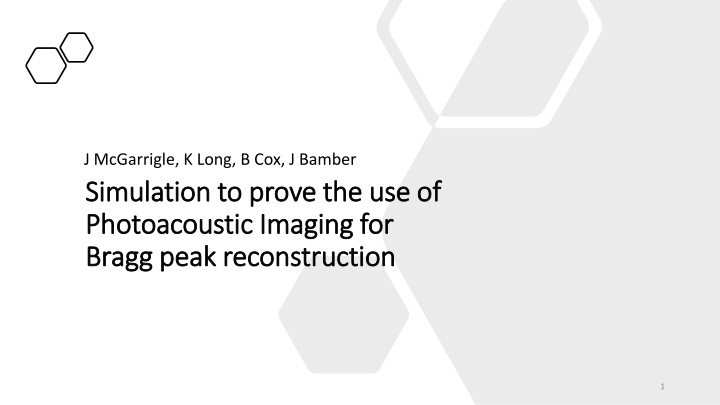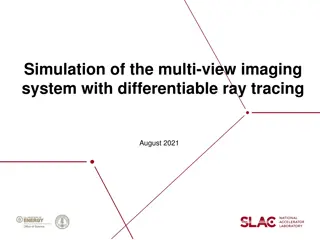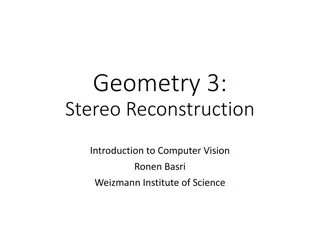Simulation Study of Photoacoustic Imaging for Bragg Peak Reconstruction
This study explores the use of simulation in Photoacoustic Imaging for reconstructing the Bragg peak in proton therapy. It discusses the concept of Photoacoustic Imaging, the generation of acoustic waves from pulsed electromagnetic radiation, and the experimental setups for characterizing proton dose distribution. The key ideas include creating a computer simulated Smart Phantom, examining thermoacoustic signals from ion beam energy loss in tissue, and using simulations to quantify radiation dose profiles. The study aims to show the viability of acoustic imaging in localizing the Bragg peak and measuring dose deposition in vivo.
Download Presentation

Please find below an Image/Link to download the presentation.
The content on the website is provided AS IS for your information and personal use only. It may not be sold, licensed, or shared on other websites without obtaining consent from the author.If you encounter any issues during the download, it is possible that the publisher has removed the file from their server.
You are allowed to download the files provided on this website for personal or commercial use, subject to the condition that they are used lawfully. All files are the property of their respective owners.
The content on the website is provided AS IS for your information and personal use only. It may not be sold, licensed, or shared on other websites without obtaining consent from the author.
E N D
Presentation Transcript
J McGarrigle, K Long, B Cox, J Bamber Simulation to prove the use of Simulation to prove the use of Photoacoustic Imaging for Photoacoustic Imaging for Bragg peak reconstruction Bragg peak reconstruction 1
Photoacoustic Imaging Biomedical imaging modality that uses ultrasound pulses generated by light beams incident on a surface. It is a hybrid modality combining the high contrast and spectroscopic based specificity of optical imaging with the high- speed resolution of ultrasound imaging with the high special resolution of ultrasound imaging. Figure 1. Examples of acoustic pulse graphs and their corresponding dose deposition profiles. (Yousefi, 2015) 2
Photoacoustic Imaging Uninterrupted pulsed beam of electromagnetic radiation incident on a material, creating a temperature increase that triggers thermoelastic expansion and the build-up of a differential pressure distribution. This pressure distribution creates acoustic pressure waves. Figure 2. A schematic of how acoustic waves are generated from a pulsed laser and how the acoustic images are generated from the resulting signals (Manwar, Zafar and Xu, 2020) 3
Existing experiments (a) Schematic of the 2D water phantom using a acoustic wave sensor to characterize the proton dose distribution. (b) Resulting proton beam scan intensity. (Arrows mark the position of the maximum). (c) Line profile of the Bragg peak in x and y direction. Figure 3. Shows the experimental setup for 2D ionoacoustic imaging of proton beams. (d) Bragg beak characterization with Al absorber. (Arrows mark the maximum of the Bragg peak). (e) Line profile of the Bragg peak in x and y direction. 4
Key ideas Create a computer simulated Smart Phantom . Examine thermoacoustic signals that are generated due to localised energy loss of ion beams in tissue. Present a way to determine the exact parameters needed to deliver a focused beam of radiation to a tumour in which the energy flux of the radiation deposited can be quantitatively imaged Use Geant4 simulations to create a dose profile. Use k-wave to examine the thermoacoustic signals. Figure 4. Graph to show the Bragg-Peak of protons overlapping the tumour for efficient radiotherapy, without an exit slope, compared to x- ray-based radiotherapy. (Proton therapy dosimetry, 2021) Show that acoustic imaging is a viable alternative method of parameterising a beam that could localise the Bragg peak and measure deposited dose in vivo. 5
Figure 5. A diagram to show the experimental set up of a phantom tank with a 17cm^2 with a 17cm^2 beam window (Barber et al., 2018) Figure 6. A flow chart to show the process of Geant4 traking particles through a medium, detailing the stages of energy deposition and the creation of new particles. (Pokorski and Ribon, 2014) Geant4 hadron therapy simulation package is a coding software that allows the tracking of particles through mediums while recording the time-frame. Geant4 Monte Carlo methods to calculate the energy deposited in the water due to the Bragg peak Follow a particle through a medium and record the energy deposition profile to see how much energy is deposited in a certain volume in a time-resolved state. This will indicate the energy that corresponds to a certain volume of water. 6
Equations of motion, continuity, and state assuming a lossless medium: K-wave Used to simulate the entire ionoacoustic propagation and detection model, including proton energy transfer to the medium, generation of acoustic waves and the propagation of acoustic waves until detection. Use the time-varying power density in each voxel from Geant4 as the acoustic input The resulting acoustic pressure fields can then be computed, a maximum output found, positions detected, and dose deposition image simulated. 7
Results Figure 7. Three binned power deposition histograms in x, y and z, with 1mm bins. 8
Results Figure 8. Three binned energy and power histograms diagrams in r, phi and z, with bins of width 0.25mm in R, 0.95744681 rads in Phi and 1mm in Z. 9
Overcome usual limitations in imaging by using photoacoustic imaging, eliminating limitations such as optical scattering. Geant4 computer programming on a simulated SmartPhantom, to show that it is possible to map an energy deposition profile, a Bragg peak and derive beam parameters by using photoacoustic imaging in order to overcome issues of mapping beam profiles in current methods such as optical scattering. Conclusions so far So far a Bragg Peak reconstruction using cartesian coordinates appears to be possible as an output of the k-wave simulation, still awaiting cylindrical results. 10
Experiment plans Figure 9. A representation of a water phantom, the basis 30cm^3 water of the simulation, showing the tank in green and the scintillating optical fibre in red. (Barber et al., 2018) Experiment includes a water phantom to measure radiation in a controlled environment, as a substitute for human muscle and soft tissue. This will be a real experiment to hopefully replicated the results from the proof of principle simulation. As shown in figure 9, it is a transparent water tank with a window for the beam to travel through and an ionisation chamber which can be moved around in order to measure the dose rate at different coordinates. 11
Figure 10. Illustration of difference between carbon ions and protons, showing contents and mass radio. Figure 11. Bragg peak comparison for proton and carbon ions Future experiments would be useful in order to explore the benefits of using this method with different types of ions that might produce a sharper Bragg peak. Further experiments 12
Questions? Questions? 13























